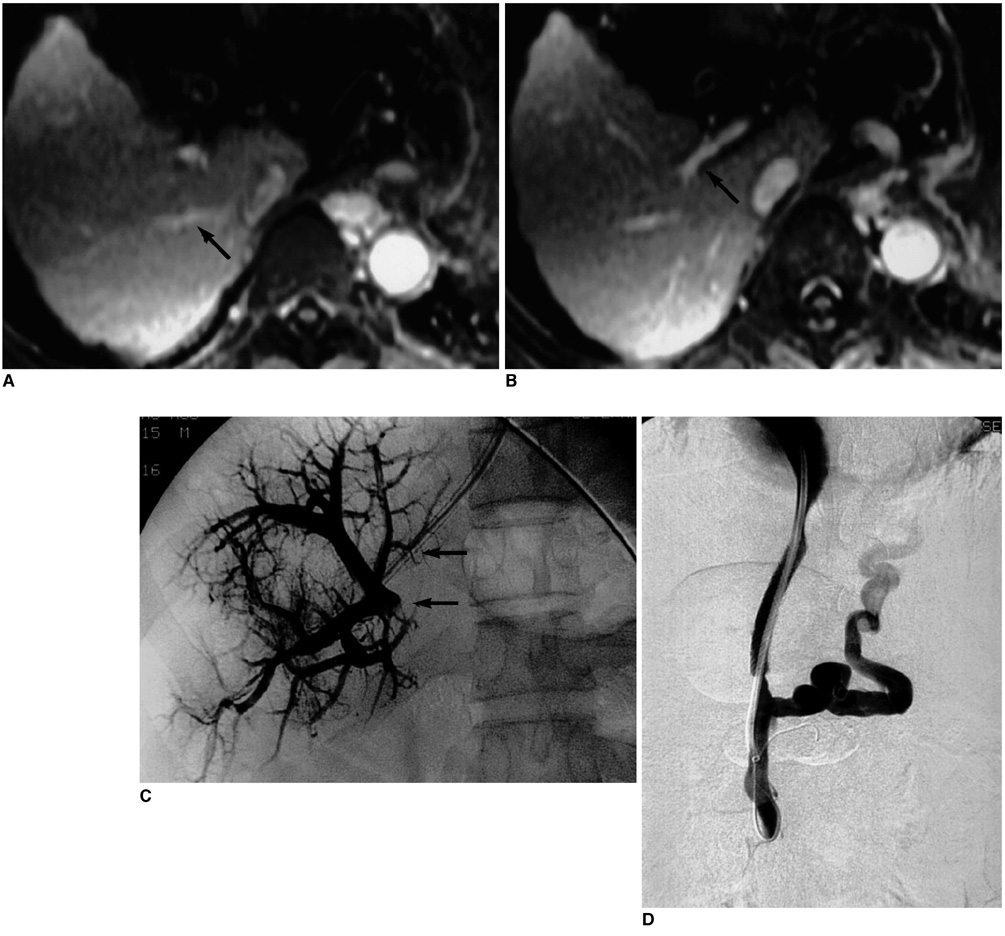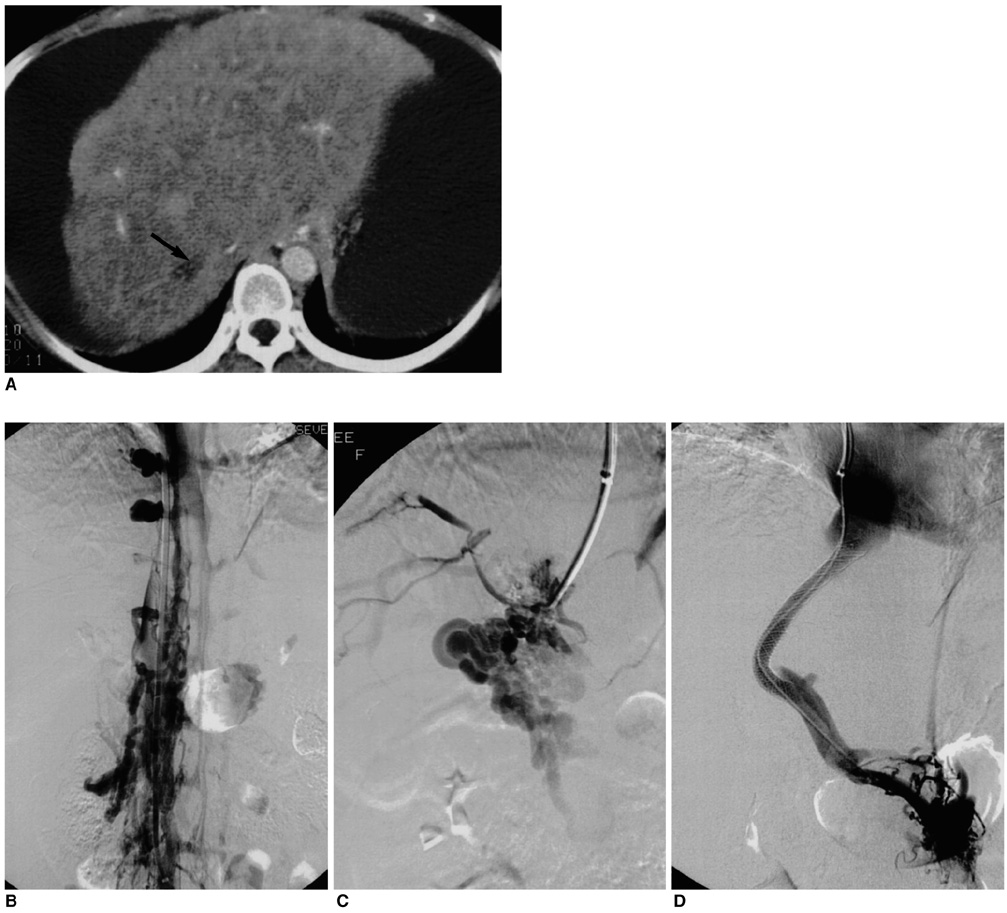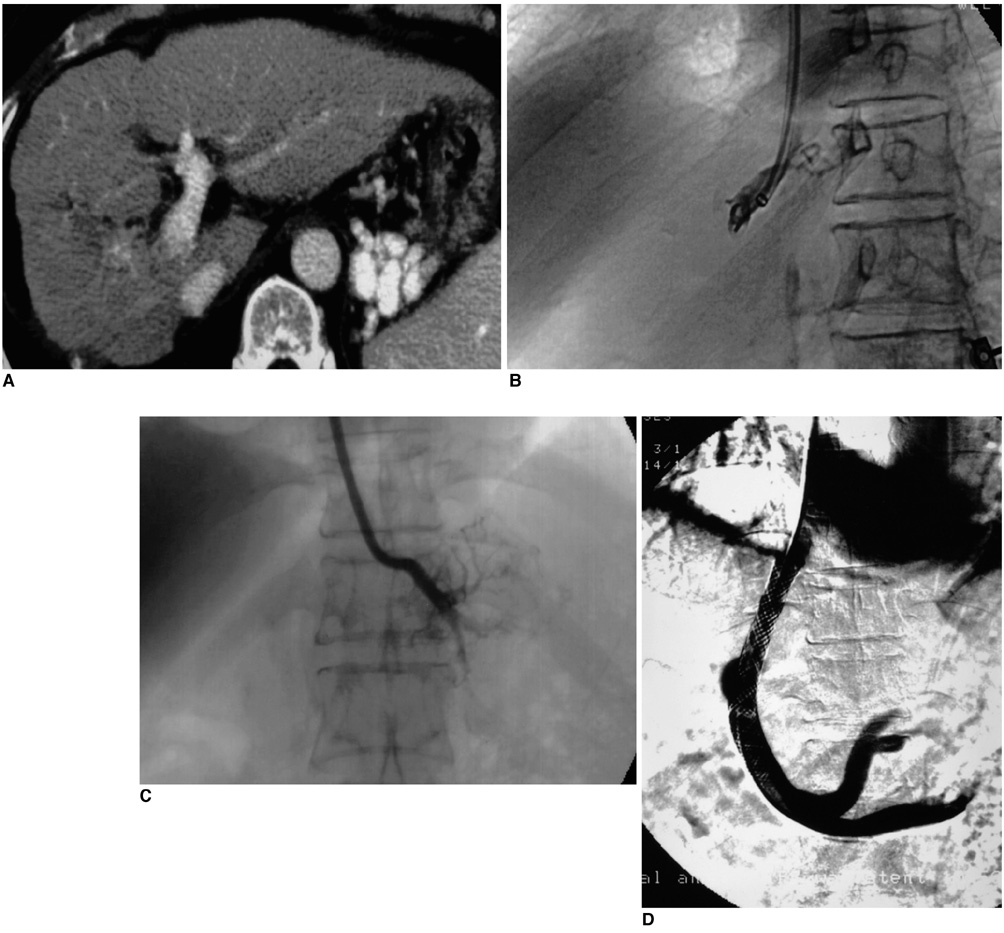Korean J Radiol.
2003 Mar;4(1):35-41. 10.3348/kjr.2003.4.1.35.
Transcaval Transjugular Intrahepatic Portosystemic Shunt: Preliminary Clinical Results
- Affiliations
-
- 1Department of Diagnostic Radiology and Research Institute of Radiological Science, Yonsei University College of Medicine, Seoul, Korea. dyl@yumc.yonsei.ac.kr
- 2Department of Diagnostic Radiology, Kangdong Sacred Heart Hospital, Hallym University College of Medicine, Seoul, Korea.
- 3Department of Diagnostic Radiology, Chonnam National University Hospital, Gwangju, Korea.
- KMID: 754040
- DOI: http://doi.org/10.3348/kjr.2003.4.1.35
Abstract
OBJECTIVE
To determine the feasibility of transcaval transjugular intrahepatic portosystemic shunt (TIPS) creation in patients with unusual anatomy between the hepatic veins and portal bifurcation, and inaccessible or inadequate hepatic veins. MATERIALS AND METHODS: Transcaval TIPS, performed in six patients, was indicated by active variceal bleeding (n=2), recurrent variceal bleeding (n=2), intractable ascites (n=1), and as a bridge to liver transplantation (n=1). The main reasons for transcaval rather than classic TIPS were the presence of an unusually acute angle between the hepatic veins and the level of the portal bifurcation (n=3), hepatic venous occlusion (n=2), and inadequate small hepatic veins (n=1). RESULTS: Technical and functional success was achieved in all patients. The entry site into liver parenchyma from the inferior vena cava was within 2 cm of the atriocaval junction. Procedure-related complications included the death of one patient due to hemoperitoneum despite the absence of contrast media spillage at tractography, and another suffered reversible hepatic encephalopathy. CONCLUSION: In patients with unusual anatomy between the hepatic veins and portal bifurcation, and inaccessible or inadequate hepatic veins, transcaval TIPS creation is feasible.
Figure
Reference
-
1. Richter GM, Noeldge G, Palmaz JC, et al. Transjugular intrahepatic portocaval stent shunt: preliminary clinical results. Radiology. 1990. 174:1027–1030.2. Zemel G, Katzen BT, Becker GJ, Benenati JF, Sallee DS. Percutaneous transjugular portosystemic shunt. JAMA. 1991. 266:390–393.3. Rossle M, Haag K, Ochs A, et al. The transjugular intrahepatic portosystemic stent-shunt procedure for variceal bleeding. N Engl J Med. 1994. 330:165–171.4. Ochs A, Rossle M, Haag K, et al. The transjugular intrahepatic portosystemic stent-shunt procedure for refractory ascites. N Engl J Med. 1995. 332:1192–1197.5. Blum U, Rossle M, Haag K, et al. Budd-Chiari syndrome: technical, hemodynamic, and clinical results of treatment with transjugular intrahepatic portosystemic shunt. Radiology. 1995. 197:805–811.6. Kamath PS, McKusick MA. Transvenous intrahepatic portosystemic shunts. Gastroenterology. 1996. 111:1700–1705.7. Rogopoulos A, Gavelli A, Sakai H, McNamara M, Huguet C. Transjugular intrahepatic portosystemic shunt for Budd-Chiari syndrome after failure of surgical shunting. Arch Surg. 1995. 130:227–228.8. Haskal ZJ, Duszak R Jr, Furth EE. Transjugular intrahepatic transcaval portosystemic shunt: the gun-sight approach. J Vasc Interv Radiol. 1996. 7:139–142.9. Soares GM, Murphy TP. Transcaval TIPS: indications and anatomic considerations. J Vasc Interv Radiol. 1999. 10:1233–1238.10. Seong CK, Kim YJ, Shin TB, Park HY, Kim TH, Kang DS. Transcaval TIPS in patients with failed revision of occluded previous TIPS. Korean J Radiol. 2001. 2:204–209.11. Chang RW, Shan-Quan S, Yen WW. An applied anatomical study of the ostia venae hepaticae and the retrohepatic segment of the inferior vena cava. J Anat. 1989. 164:41–47.12. Camargo AM, Teixeira GG, Ortale JR. Anatomy of the ostia venae hepaticae and the retrohepatic segment of the inferior vena cava. J Anat. 1996. 188:59–64.13. Saxon RR, Keller FS. Technical aspects of accessing the portal vein during the TIPS procedure. J Vasc Interv Radiol. 1997. 8:733–744.14. Haskal ZJ, Cope C, Soulen MC, Shlansky-Goldberg RD, Baum RA, Redd DC. Intentional reversible thrombosis of transjugular intrahepatic portosystemic shunts. Radiology. 1995. 195:485–488.15. Brountzos EN, Alexopoulou E, Koskinas I, Thanos L, Papathanasiou MA, Kelekis DA. Intraperitoneal portal vein bleeding during transjugular intrahepatic portosystemic shunt: treatment with stent-graft placement. AJR Am J Roentgenol. 2000. 174:132–134.16. Davis AG, Haskal ZJ. Extrahepatic portal vein puncture and intra-abdominal hemorrhage during transjugular intrahepatic portosystemic shunt creation. J Vasc Interv Radiol. 1996. 7:863–866.17. Haskal ZJ, Davis A, McAllister A, Furth EE. PTFE-encapsulated endovascular stent-graft for transjugular intrahepatic portosystemic shunts: experimental evaluation. Radiology. 1997. 205:682–688.18. Haskal ZJ. Improved patency of transjugular intrahepatic portosystemic shunts in humans: creation and revision with PTFE stent-grafts. Radiology. 1999. 213:759–766.19. Woodle ES, Darcy M, White HM, et al. Intrahepatic portosystemic vascular stents: a bridge to hepatic transplantation. Surgery. 1993. 113:344–351.20. Lerut JP, Laterre PF, Goffette P, et al. Transjugular intrahepatic portosystemic shunt and liver transplantation. Transpl Int. 1996. 9:370–375.
- Full Text Links
- Actions
-
Cited
- CITED
-
- Close
- Share
- Similar articles
-
- A new and improved transjugular intrahepatic portosystemic shunt (TIPS) stent graft: Controlled expansion
- Percutaneous retrieval of a misplaced transjugular intrahepatic portosystemic shunt stent using the rigid endobronchial forceps
- A Successful Endoscopic Therapy for Uncontrolled Duodenal Varix after Transjugular Intrahepatic Portosystemic Shunt
- Transcaval TIPS in Patients with Failed Revision of Occluded Previous TIPS
- Transjugular intrahepatic portosystemic shunt trends in China: A brief review




